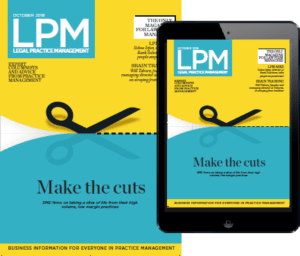
Which version is the right one?
The complexity of legal workflows means a single document will get edited several times. The best way to marry up all versions and spare the confusion of finding the right one, is to use a DMS, says Kaden Smith, director at NetDocuments.
By their nature, legal matters require complex workflows, with many documents going back and forth between opposing counsel, clients, and others for negotiation and revisions. Sometimes, those rounds of edits can even occur within the firm. Almost always, those versions need to be maintained in case changes need to be reverted or comparisons run. Do you have the proper tools to help reign in the chaos that can ensue as you begin working with versions upon versions of documents?
This is where a document management system (DMS) can really pull its weight in time-savings, reduced frustration and efficiency gains for your team. For example, instead of emailing copies of documents and then having to manually incorporate changes from multiple parties, you can simply share a single document via a collaboration space and use the co-authoring function to allow multiple people to make edits in a single document, greatly reducing the complexity and risk of errors in your review cycles. This also provides the ability to accept or reject changes and build onto the amendments others have made. Not only is the editing easier, but the security and confidentiality is maintained, because the document remains safely stored in the DMS versus copies existing in numerous places. The added bonus is that your email inbox is less chaotic.
In-house review cycles can sometimes be cumbersome to manage as well. With the availability of sub‑versions, your clients never have to see that you’ve had four different people weigh in on one version of the document and ended up with version numbers running into the triple digits over time. When you’re ready to present the changes to the other parties, you can choose when the proper time to “version up” occurs, so your in-house versions would be 4.1, 4.2, 4.3, etc. and then you would version up to version 5.0 when in-house changes are complete.
Say goodbye to instances of documents named “final, final, final”! A modern DMS like NetDocuments can help your firm avoid confusion no matter how many versions are needed to finalise a document, improve collaboration internally and with external parties and elevate client services while minimising risk.

Leveraging the best of both worlds
Combining a cloud-based document management system (DMS) with your existing case management system (CMS) can unlock powerful features to help your firm gain a competitive advantage, says Kaden Smith, director at NetDocuments.
Small to midsize law firms utilise CMSs to help manage their business, but as demand grows for cloud-based solutions that enable secure, collaborative remote work, many are finding their CMS doesn’t provide the robust features needed to support the entire document lifecycle.
Are your case documents and emails organised and easy to find, revise, bundle, share, have signed and filed –– all from a single platform you can access anytime, anywhere?
This is where firms are differentiating themselves: by taking advantage of the benefits of a powerful cloud-based DMS while continuing to maintain their CM for backend functionalities.
Why firms are turning to DMSs
With robust search capabilities, metadata tagging, access controls and advanced security features, a DMS can bring significant benefits to your workflow and productivity.
Some key features of a DMS include creating and editing documents, organising them by matter or project, securely sharing and collaborating on documents, tracking version history, accessing workspaces and documents remotely, controlling user access permissions, applying custom metadata, finding content efficiently, integrating with preferred software solutions, and maintaining advanced security and governance.
With a cloud-based DMS, with open APIs, firms can seamlessly connect their DMS to case management technology or any other solutions your teams use for their workflows.
Cloud vs on-prem
When it comes to choosing a DMS, there are two options: cloud-based and on-premises (plus many variations in between). While on-premises solutions offer total control of the system within your organisation, they can be expensive and difficult to set up and maintain. On the other hand, cloud-based solutions have grown in popularity due to their significant cost savings and benefits, such as security and mobility. With a cloud-based DMS, the management and upkeep of hardware, software, security and personnel are the responsibility of the cloud provider, and business users can access the DMS via the internet.
True cloud also offers benefits such as increased security, compliance, and backups. Legal professionals and other businesses or organisations that deal with confidential data can have peace of mind knowing that their important data and documents are being protected at the highest level. Additionally, with cloud solutions, users can securely access their data using any device, enabling teams to work remotely with ease, increase productivity, and provide better service to clients.
The best of both worlds
A modern DMS can be a powerful foundational platform for all of a law firm’s work. As you transition more technologies to the cloud, you’ll want to ensure you select providers that offer strong open APIs that will allow you to connect all of the tools your teams need to be able to do their best work while improving workflows, enhancing security and enabling better collaboration.
Most Popular

Where are the challenges for SME law firm leadership changing?

The leading annual picture of SME law firms' changing strategic priorities
TA Triumph-Adler provides tailored support to meet compliance requirements

Law firms undertaking identity verification checks must register as an ASCP

Robust onboarding processes are fundamental to effective risk prevention

Osprey Approach's webinar explores the benefits of a digital-first approach

Bringing systems together
An optimised selection of cloud-based solutions, seamlessly integrated, could unlock significant strategic advantages for your law firm, says Kaden Smith, director at NetDocuments.
Building your law firm’s tech stack is a process filled with questions: Which systems are essential as opposed to nice to have? Which ones will deliver the greatest return on investment (ROI)? Where can technology result in strategic advantages for your firm?
At the same time, the ways in which people want and need to work have changed, and clients (and potential clients) are expecting better, more modern experiences from their legal service providers.
The key to success – the right combination of cloud-based legal technology tools, seamlessly connected. This enables your people to do their best work and results in better experiences – both internally and for clients.
Elevated case management
The pandemic forced many firms to quickly adapt to some form of remote work, which brought on a surge in adoption of cloud-based technologies. Firms realising accelerated success today are going beyond the cloud-based version of their case or practice management solution (CMS) and adding a powerful document management system (DMS) to elevate the way they work.
Documents are at the heart of how law firms operate, so providing lawyers with tools to access and share important files easily and securely is critical to efficient and more profitable business operations.
Like many organisations using an existing CMS to store and manage documents, searching for and collaborating on files can be difficult – especially for professionals who spend their day working in Word or Outlook, as it takes time to switch between different applications. With a DMS connected to or embedded in your CMS, users can work in Word, Outlook, Teams, Gmail – or any other day-to-day cloud-based applications – and keep documents, emails and other confidential content securely organized and easy to find, access and share.
And then there’s automation
With the combined power of a cloud-based CMS and DMS, your firm can further streamline efficiencies and workflows. Document automation and assembly solutions built into the DMS allow law firms to automate their expertise to produce simple to complex legal document packets. For example, your technology could walk someone through each step in the matter opening process, create the matter workspace, and automatically populate templated documents, which then get saved to the correct locations within the DMS.
But that’s just the beginning. Together, your CMS and DMS solutions can combine to enable you to optimise and even automate many time-consuming and mundane processes, reduce errors, increase productivity and boost efficiency for your firm while increasing your security posture.
This winning technology combo can even help your team improve client service and gain a strategic advantage over the competition.
Most Popular

Where are the challenges for SME law firm leadership changing?

The leading annual picture of SME law firms' changing strategic priorities
TA Triumph-Adler provides tailored support to meet compliance requirements

Law firms undertaking identity verification checks must register as an ASCP

Robust onboarding processes are fundamental to effective risk prevention

Osprey Approach's webinar explores the benefits of a digital-first approach
Closing the automation gap
A set of SME legal leaders and experts came together for the second episode of LPM Tiger Team 2023, in partnership with NetDocuments, to understand why firms are yet to achieve their automation potential, and share their experience of automating processes.
While there is widespread acknowledgement for the value that automation could bring to SME law firms – based on LPM Frontiers research from recent years – large segments of the SME legal market remain hesitant to take the automation plunge. Why? We brought together a set of business leaders from sector with a diverse range of expertise to try and understand the key issues.
The first key challenge raised by our Tigers was understanding how much of they firms’ operations really have the scope to be automated. Sean Stuttaford, chief operations officer at Thompson Smith and Puxon, described how his firm undertook an exercise at the cusp of its automation journey a decade ago – plotting the various types of work along a spectrum of ‘bespoke’ to ‘standardised,’ ‘systemised’ or ‘commoditised.’ A complex undertaking in itself, he reveals that it can also be a controversial exercise, stating that “lawyers tend to think their work lies more towards the bespoke side of the spectrum.” The next step was to identify a target position on the spectrum based on the firm’s strategic goals – placing client needs at the core of this work, while prioritising efficiency and costs savings, particularly under the current circumstances.
Lindey Dewart, practice manager at Thomas Flavell & Sons, noted that property work occupies a significant position at her firm, which made it a good starting point to examine the entire client journey and identify automation opportunities. For her, the biggest challenge was adoption – “it’s hard for lawyers to rely on a third party to handle certain aspects of their work, so there was a lot of resistance to change at first.” Rolling the solution out on a pilot basis and allowing others to realise the benefits and adopt the technology organically proved to be an effective strategy for the firm.
According to Andy Vigus, finance and operations director at Talbots Law, distinguished between the cultural side and the investment side of automation. Risk averse cultures at the management level in law firms can block new investments – it’s hard to know for sure if new technology will deliver value, so it’s crucial to convince people that it’s necessary for future competitiveness. For lawyers, they need to be convinced that automation doesn’t threaten the value of their work, or their job itself. Given the volumes of work that firms are dealing with at the moment, he argues that it’s easier to convince lawyers that only part of their work is being automated, and that they’ll be freed up to do more lawyering. According to Stuttaford, promoting a growth mindset, more generally speaking, can help create more openness to change.
Also on the panel was Mike Kaye, senior solutions expert from NetDocuments, who brought a product perspective to the discussion. According to him, technology providers have the expertise to help firms conduct their gap analyses and needs assessments, so it helps to get providers involved in the discussions early. Another thing that suppliers can help with is measuring returns on investment (ROI) – Kaye reveals that NetDocuments has an ROI model for firms, which can help them identify how much repetitive work is being done by each individual and multiply it by the number of individuals to provide a full picture of how much time can be saved. The model has room for monetary evaluations too, though not all administrative work within the firm that can be automated is necessarily billable. Still, knowing how much time is being saved, and returned so lawyers can do more billable work, can help firms identify the value of automation.
All these strategies can help convince people at all levels within an SME law firm that automation is the best way forward. The panel also discussed challenges that come once automation begins – from training and utilisation to costs, risks and, importantly, integration challenges.
Most Popular

Where are the challenges for SME law firm leadership changing?

The leading annual picture of SME law firms' changing strategic priorities
TA Triumph-Adler provides tailored support to meet compliance requirements

Law firms undertaking identity verification checks must register as an ASCP

Robust onboarding processes are fundamental to effective risk prevention

Osprey Approach's webinar explores the benefits of a digital-first approach

Striving for record-breaking productivity
Nearly a quarter of a lawyer’s time is spent doing tasks that can be automated, leaving significant potential to boost productivity, says Kaden Smith, director at NetDocuments.
When choosing which technology to invest in, it’s difficult to balance single-use point solutions that do one thing well with platforms that do many things. What is most critical to your productivity is selecting cloud-based technologies with strong integrations between the components of your ideal tech stack to support and enable complete workflows.
Cloud technology is the standard in modern law firms with 76% of firms either already in the cloud or choosing cloud-native solutions, because robust APIs that aren’t locked behind on-premises doors expand their combined capabilities and streamline workflows.
Assembling documents, transferring data, pushing projects through reviews and approvals –these tasks, and more, can be streamlined or automated using integrated systems.
Three benefits of integrated cloud platforms
1. More efficient workflows
Law firms rely on numerous technologies on a daily basis. Manually transferring data and documents from one platform to the next can be a taxing process, time-consuming and error-prone.
Integrating tools so they can communicate seamlessly makes workflows more efficient, reducing manual work and the risk of embarrassing errors.
2. Less time spent on low-value tasks
Lawyers are a firm’s most valuable assets, so why waste their time and cognitive bandwidth on low-value tasks when it could be better spent on more meaningful work?
It’s estimated that 23% – nearly a quarter of their day – doesn’t actually require their personal involvement and could be automated.
To improve your bottom line, move tasks to the least costly resource available to do them well. Many times, the best solution is well-applied and integrated technology with humans overseeing versus manually performing tasks.
3. Ease of access
When systems aren’t integrated, it becomes difficult to find what you need. Documents and data get scattered and siloed across various platforms and devices, leaving legal professionals wasting time digging through dozens of places to locate information.
Fully integrated systems enable you to easily access the information you need. All your most important documents and data are always at your fingertips.
Evaluate your tech for record-breaking productivity possibilities
Now is the time to evaluate whether your current technology solutions are supporting your business goals. Ask yourself:
- Are your workflows efficient and streamlined? Or are they filled with annoying friction points and duplicative efforts?
- Is your team empowered to focus on high-value tasks? Or are they being stymied by mundane, repetitive tasks?
- Can they find what they need? Or are they trapped in endless search cycles?
Integrated technologies are a powerful way to get your team on the path to realising record-breaking productivity and greater satisfaction.
Most Popular

Where are the challenges for SME law firm leadership changing?

The leading annual picture of SME law firms' changing strategic priorities
TA Triumph-Adler provides tailored support to meet compliance requirements

Law firms undertaking identity verification checks must register as an ASCP

Robust onboarding processes are fundamental to effective risk prevention

Osprey Approach's webinar explores the benefits of a digital-first approach
Core business systems: the good, the bad and the ugly
In the first episode of LPM Tiger Team 2023 in partnership with NetDocuments, LPM editor, Aftab Bose quizzes SME legal leaders about what forms the core of their business systems, and if their core tech feeds into positive business outcomes.
Legal tech is a prolific industry – new tools, solutions and versions of varying abilities arrive on the scene at a faster pace than many law firms are capable of monitoring. Choosing the right systems while also managing internal operations, client work and wider economic developments is already a significant challenge. And once the choice is made for better or worse, implementation is a whole new journey riddled with its own challenges such as integration, adoption, utilisation and more.
These are some of the challenges that were under the spotlight during the first episode of LPM Tiger Team in partnership with NetDocuments – a series of problem-solving webcasts where a set of SME legal leaders bring a diverse range of expertise to analyse specific tech pain points. Key questions addressed on the webinar included – ‘what constitutes a firm’s core technology?’ and ‘how can firms make the most of the tech they have onboarded?’ Our panellists, or ‘Tigers’, have all been in charge of major tech investments – they shared their top tips and experiences.
For Alan Cousins, practice director at Paris Smith, a key dichotomy that comes up when selecting core tech is whether to opt for a ‘one-stop-shop’ solution that serves multiple functions, or pick a variety of tools that are ‘best-of-breed’. Each comes with it’s own perks and challenges. Cousins reveals that Paris Smith recently moved from the best-of-breed approach to a single solution for multiple functions – mainly to ensure that the change would have a tangible and widespread impact.
The downside of this approach is that firms are at the mercy of the provider’s own intentions and roadmap. According to Cousins, it’s crucial to understand whether a tech company has a long-term vision to develop its product, or whether it’s looking to achieve a certain reputation and then merge with a bigger company – the latter can cause significant disruption. And even in the former scenario, it’s important to know whether the long-term vision suits your business.
Julia Warrilow, finance and operations director at Thursfields, reveals that her firm is going through the reverse journey – having relied on a single solution for years, it’s now reaching maturity and the firm is examining best-of-breed options. Her first port of call has been to speak to people within the business and understand their pain points. The challenge is also to convince decision-makers of the value of a particular system – Warrilow says that putting a financial value on returns from tech investments is very tricky. Her firm looks at client demands and what competitor firms are offering to gauge the need for tech investments.
But once the needs have been identified – based on internal considerations and external pressures – the next obstacle is having an open conversation with clients. The Tigers unanimously agreed that a lot of sales pitches fail to understand unique business needs – in fact, they can often distract firms from their actual requirements. The result is that firms are often left disappointed with their tech.
According to Wayne Lord, head of IT and business improvement at CFG Law, the key is preparation. He revealed that he was in the fortunate position of having two years to do market research and prepare a concrete brief of the exact solutions that were needed at his firm – complete with a matrix of questions for suppliers. Hi approach was to spend time speaking with various suppliers, watching their demos and using his matrix of questions to align everything with business needs.
Across the board, the Tigers agreed that no solutions are going to perform every function that law firms require. As outlined by Alan Cousins, it’s important to have a list of ‘nice-to-haves’ and a set of ‘dealbreakers’ – the latter should form the core of your decision criteria, while the former is helpful to tip the scales when comparing similar offerings. Meeting other firms to understand their first-hand experience of a particular system can also be effective.
Mike Kaye, senior solutions expert at NetDocuments offered the industry view on these challenges. According to him, while the supplier does carry the responsibility of understanding a firm’s challenges, it helps if the firm already has a clear idea of where it needs improvement. Many times, firms can discover that the solutions they use have undiscovered functionalities that could solve their specific challenges. The key is for both sides to approach discussions with preparedness and transparency to avoid conversing at cross-purposes.
Most Popular

Where are the challenges for SME law firm leadership changing?

The leading annual picture of SME law firms' changing strategic priorities
TA Triumph-Adler provides tailored support to meet compliance requirements

Law firms undertaking identity verification checks must register as an ASCP

Robust onboarding processes are fundamental to effective risk prevention

Osprey Approach's webinar explores the benefits of a digital-first approach

The art of change management
Change management needs to be central to your team’s culture to successfully embrace today’s new and tomorrow’s unknown, says Kaden Smith, director at NetDocuments.
Today’s rate of change is near constant, and change can be difficult regardless of your firm size. And, whether you have an on-premise system where updates come every several years, and IT teams spend months testing and planning for them – or a cloud-based technology with updates released frequently – it’s critical for your business to understand the foundational principles of change management and how to navigate the “people” side of change.
The challenges of change
Some law firms might not have been diligent about keeping up with technology advancements, while others have team members who are change-averse (which agrees with lawyers’ tendency to be risk-averse). Whether changes are big or small, they come with a range of potential challenges, including:
- Underutilised features and functionality
- Frustration as people navigate the new
- Lack of adoption and loss of ROI
Adaptability, leveraging technology to improve processes, and resilience are key strengths needed to thrive in today’s business world. To keep up with the pace of change and stay competitive, law firms should develop processes that help people embrace their firm’s latest technology changes, and thrive as a result.
Four steps to a successful culture of change
For those interested in diving into the world of change management, there are numerous certification courses available, including those by Prosci and the Association of Change Management Professionals. But for most of us, these four steps can help ensure your people are set up for success.
- Get buy-in. People need to understand ‘why’ a change is necessary. When it comes to new software, getting buy-in from top leadership is a key priority, followed by helping others understand the benefits they’ll experience because of the change.
- Choose a platform that makes it easy. It takes effort to identify a tool that will fit your team’s way of working and solve problems without creating new, potentially worse, ones. Start with a clear understanding of your team’s current workflows and where it needs improvement. Make sure to ask the right questions as you begin evaluating potential solutions, and don’t forget to keep one eye on the future.
- Don’t go it alone. No one wants to feel like change is being foisted on them. Identify power users and nurture champions who can help encourage and guide others. If you really want to drive adoption, make sure you have advocates across the organisation.
- Communicate early and often. Studies have shown that people need to see something at least seven times before it sinks in. Keep that in mind as you’re sharing news, tips, training, or other helpful information. I’m not saying email something seven times – use email, printouts, newsletters, intranet, or whatever mediums you have at your disposal.
Eliminate fear of change
As your firm and teams adopt the principles of change management into daily practice, people will become more aware of the technologies that can make them more productive and efficient. And your firm will benefit from realising higher ROI and more engaged, positive work environment as people feel enabled to utilise the technologies selected to help them do their best work.
Most Popular

Where are the challenges for SME law firm leadership changing?

The leading annual picture of SME law firms' changing strategic priorities
TA Triumph-Adler provides tailored support to meet compliance requirements

Law firms undertaking identity verification checks must register as an ASCP

Robust onboarding processes are fundamental to effective risk prevention

Osprey Approach's webinar explores the benefits of a digital-first approach

Four benefits of enterprise search
Your business has droves of valuable knowledge – Kaden Smith, director of inside sales, EMEA at NetDocuments, explains how enterprise search can help your firm make the most of its assets.
According to a recent report published by KMWorld, lawyers can spend up to 22% of their work hours searching documents scattered across dozens or more internal data sources. What if finding information across all the data sources in your organisation was as easy as doing a single Google search? Welcome to the world of enterprise search.
The term “enterprise search” refers to technology that brings an internet-like search experience to finding and retrieving relevant documentation, data, and knowledge that are stored in various formats across multiple databases within an organisation. Enterprise search empowers your teams to benefit from the combined knowledge from across all internal data sources, presented in a more holistic view.
With enterprise search, content from all your information sources, such as documents and email stored in document management systems (DMS), websites, intranets, CRM tools, financial systems, and more, can be indexed and made easily searchable.
Why enterprise search is important
Knowledge is power. For knowledge workers who deal with significant amounts of documentation, such as law firms, large businesses, and public sector entities, enterprise search has become a valuable — and even mission-critical — tool for daily operations. This is because it dramatically reduces the time it takes to retrieve all the most relevant records an individual intends (and has access) to find. Everything can be found in one place versus having to search in multiple locations.
Most technology platforms are designed with the purpose of doing one or a few things really well – a CRM keeps all client data together in one place, accounting platforms track billing information, and so on. But many times, a business will need to access a combination of all these different records housed within siloed sources. With enterprise search, a single search query allows you to surface the information you need, regardless of where it’s stored, eliminating the need to repeat searches in each location. Additionally, you can see the data in relation to the content in the other data sources, giving you a bigger picture view.
How enterprise search works
For a piece of content to be searchable, it must first be indexed so the enterprise search system can recognise and find all available details about the file. Some legacy systems have outdated structures that require an IT department to manually submit new and updated indexes, while other systems do their own indexing of each document and email.
Enterprise search can automate this process, lessening and even eliminating the need for IT involvement by using live connectors that are continuously indexing multiple data sources at once, instantly presenting all of these results together in one unified interface.
Top four benefits of enterprise search
Enterprise search technology is changing the way businesses find and access their data in significant ways. Here are just some of the benefits you can expect by implementing an enterprise search solution:
- Find everything you need in one search
Enterprise search allows you to tap into all your available information sources and have a single, authoritative source for your organisation’s best and official answers. Being able to see data in the context of its relationship with other data builds a more complete information picture.
Unifying and centralising those searches in a one-stop-shop makes accessing and referencing historical documentation, data, and knowledge easier than ever before.
- Enhance your organisation’s knowledge management
Think about how many times you’ve needed to find that person in your organisation who knows about a specific subject matter, client need, or information from a project done several years ago. Organisations are packed with knowledge and years of valuable expertise spread out across digital archives, as well as inside the minds of staff. Many times, our colleagues have knowledge buried in resumes or CVs from prior jobs and experience. In addition to making day-to-day operations easier, enterprise search also turns your firm’s existing records into a vast knowledge base.
With a thorough way to search, employees of all experience levels can self-serve the wealth of knowledge that already exists inside your organisation. New employees can get up to speed quickly, subject-matter experts can be identified more easily, and better business decisions can be made based on historical knowledge.
- Maintain data security and ethical walls
Protecting your data against cyberattacks should be a top priority, but it’s just as important to prevent unmitigated access to sensitive information by unauthorised personnel. These risks are being amplified with most organisations supporting remote and hybrid work environments and cyberattacks targeting potential vulnerabilities.
Fortunately, enterprise search honours the security set in the systems of record and allows for additional data restrictions that can help keep sensitive information away from individuals without proper access rights. When someone performs a search, they are presented with only the information to which they have been granted access — and nothing else.
- Save time through automated document indexing
When dealing with thousands or millions of files, the indexing process can cause delays and frustrations. Anyone looking for information that hasn’t been indexed yet will be unable to find what they need until the system has time to catch up.
Enterprise search can automate this process by using live connectors that are continuously searching multiple data sources at once, essentially repurposing the index already created by the native applications, such as Outlook, Teams, or your document management system (DMS).
Empower your people with search
Gone are the days of needing to go to different systems to search for the internal information you need and searches that don’t provide the experience users are expecting. Today’s modern enterprise search provides easier, faster, more relevant results that can help your organisation save time, enhance knowledge management and sharing, and maintain data security and ethical walls.
Want to learn more about enterprise search for law firms? Download this free whitepaper to discover all you need to know.
Most Popular

Where are the challenges for SME law firm leadership changing?

The leading annual picture of SME law firms' changing strategic priorities
TA Triumph-Adler provides tailored support to meet compliance requirements

Law firms undertaking identity verification checks must register as an ASCP

Robust onboarding processes are fundamental to effective risk prevention

Osprey Approach's webinar explores the benefits of a digital-first approach

Combining systems for an accelerated strategic advantage
Practice management systems and document management systems have distinct value that can combine to bring efficiency, security and productivity advantages – says Kaden Smith, director of inside sales, EMEA, at NetDocuments.
Among the many tools SME law firms rely on are solutions for practice management and document management. While some practice management systems (PMSs) come with a document management component, they cannot provide the complex security and governance features required for critical client documents and emails or the productivity boosters that can elevate your firm’s work.
That’s where a powerful document management system (DMS) comes in. And while some smaller firms are still discovering the overall benefits of a DMS, other firms have both a PMS and DMS but have yet to connect them to experience more efficiencies and realise even greater value from their technology investments.
Our recent eBook on combining the power of a PMS and DMS for small and midsize law firms is here to help. It provides a deep dive into why you need both systems, benefits of integrating these tools, best features to leverage in each, and case studies of firms finding success by integrating their PMS and DMS.
Here is a sneak peek into some of what gets covered.
Top benefits of integrating your PMS and DMS
Individually, legal practice management and document management platforms offer substantial benefits for law firms. But believe it or not, these two systems are better when connected and used together. Here are a few key advantages your firm can expect when you integrate a legal PM software and DMS.
Find the information you need quickly
How much time do you and your team spend looking for files, emails, and documents each day? According to a McKinsey report, employees spend 1.8 hours every day searching for and gathering information.
DMSs can dramatically reduce search time and increase productivity. With customisable home pages, ‘recent’ and ‘favourite’ documents lists, and advanced search capabilities like natural language processing, filters and boolean operators, DMS users can quickly and easily track down files in the DMS repository.
Integrating a DMS and PMS can make the process even faster by linking clients and matters, which comes with many benefits such as viewing documents saved in the DMS without leaving your PMS interface.
Access everything from anywhere
With integrated systems, you can easily access information from each system, no matter which one you’re currently working in. Just as you can pull data from your PMS into document templates, you can also retrieve matter-related documents and emails within the PMS workspace. You can also see different document versions, review security or user permissions, sort and organise documents, and achieve a lot more to help your work move smoothly and efficiently.
Increase productivity with more efficient workflows
When you improve the full document lifecycle by utilising technology, you experience major gains in productivity and reduction in frustration from having to move between multiple systems and shuffle documents around from place to place to get work done. Imagine if you could pull content into a document from the PMS, easily complete document edits online, instantly send a document for electronic signature, and then have the document automatically come back saved to your matter workspace in the DMS.
Secure and protect your data
Losing or exposing confidential data is not something your firm wants to deal with, whether it happens accidentally or maliciously. Operating without a DMS leaves your documents dangerously exposed to risk. PMS-based document components lack the rigorous security protocols needed to protect a law firm’s documents and data.
Your DMS can provide robust built-in security plus safeguards like document-level encryption, multifactor authentication (MFA), and data loss prevention (DLP), which provide greater protection against ransomware and malicious actors. You can also prevent actions like document sharing or printing. Integrating a DMS with your PMS provides stronger protection for your most confidential information while still enabling collaboration when needed.
Collaborate internally and externally
Both a PMS and DMS have tools to make collaboration smoother without cluttering up your email inbox. But a DMS makes it easy to share, edit, review, annotate, and discuss documents securely — all without the challenges of local copies, untracked changes and version conflicts, among others. As conversations move from email to platforms like Microsoft Teams and Slack, a DMS can make securely sharing files with a group much easier.
Integrate with your other technology
Practice and document management aren’t the only systems your team relies on day to day. Fortunately, both PMSs and DMSs integrate with a variety of other products, such as time and billing software, project management solutions, electronic signature and filing platforms, contract management tools, Microsoft Office, Adobe Acrobat and many more. A fully integrated tech stack means less bouncing between platforms and less work for your team. Your software applications do the heavy lifting, so you can get back to focusing on clients.
Better together: create synergy between your PMS and DMS
The combination of practice management and document management yields more than the sum of each system’s parts. You can get more value from your PMS because of your DMS, and vice versa — and that synergy is something you can leverage to take your practice to the next level.
Where a PMS is ideal for things like calendar synchronization, timekeeping, and billing, many functions are better handled by a DMS, such as document automation and assembly, controlled document access with ethical walls and access rights, real-time messaging, advanced version control, integrations with Microsoft and other tools you use daily, and more.
Together, PMS and DMS solutions combine to enable you to optimise and even automate many time-consuming and repetitive processes, increase productivity, and create cost efficiency for your firm while increasing your security posture. This winning technology combo can even help your team improve client service and gain a strategic advantage over the competition.
Most Popular

Where are the challenges for SME law firm leadership changing?

The leading annual picture of SME law firms' changing strategic priorities
TA Triumph-Adler provides tailored support to meet compliance requirements

Law firms undertaking identity verification checks must register as an ASCP

Robust onboarding processes are fundamental to effective risk prevention

Osprey Approach's webinar explores the benefits of a digital-first approach

Automating your expertise – where to begin?
Legal document automation solutions are making it easier than ever to streamline workflows and reduce the amount of time spent on repetitive manual processes, says Kaden Smith, director of inside sales, EMEA, at NetDocuments.
By automating tasks such as generating contracts, agreements, applications, opinions, pleadings, or entire sets of documents, you can increase both the volume and value of the service you deliver to clients, customers, and business stakeholders.
However, not all automation solutions are well-suited for the rigours of legal work, and it can be a challenge to get started as well as ensure you’re receiving the maximum benefits from document and workflow automation technology.
A recently published guide by NetDocuments offers insight into how automation is solving common challenges impacting law firms of all sizes, corporate legal departments, and legal professionals in the public sector. It also examines what to look for in a technology solution that will grow with your firm and how to develop a plan for getting started.
What is legal document automation?
Automation refers to using technology to execute tasks, processes, and workflows — either in part or in their entirety — minimising the need for human time and effort. Legal document automation streamlines the tedious, labour-intensive processes and manual tasks necessary for legal document work, such as data entry, information or service intake requests, bulk document creation, and more.
Solve your firm’s top document and workflow challenges
Regardless of your practice or area of focus, the amount of time involved in doing even simple manual tasks can put an immense amount of pressure on your workforce, especially for growing law firms looking to increase their client base and legal departments trying to keep pace with the demands of the business.
Automation technology can help your organisation significantly reduce repetitive work as well as deliver other benefits, such as:
- Build custom web- or app-based forms for matter or project intake
- Better serve your clients or business stakeholders
- Create large volumes of high-quality, error-free documents
- Automate complex legal logic in your documents
- Increase efficiency to reduce labour costs
- Stay ahead of the competition
- Modernise your practices and workflows
- Free up time for higher-value work
If you’re ready to move away from manual processes and improve the quality of your outcomes, download “Automate Your Expertise! Where to Begin”.
Let NetDocuments help you automate your expertise
As the world’s #1 trusted cloud-based content management and productivity platform, NetDocuments helps legal professionals do their very best work. Our solutions are designed from the ground up with legal work in mind, helping your team create and manage high volumes of documents with ease while also providing the level of security required for sensitive and privileged information.
Request a demo today to discover how our PatternBuilder document and workflow automation solution can help you easily replicate and automate your unique templates and processes, so they’re done the right way — your way — every time.
Most Popular

Where are the challenges for SME law firm leadership changing?

The leading annual picture of SME law firms' changing strategic priorities
TA Triumph-Adler provides tailored support to meet compliance requirements

Law firms undertaking identity verification checks must register as an ASCP

Robust onboarding processes are fundamental to effective risk prevention

Osprey Approach's webinar explores the benefits of a digital-first approach




